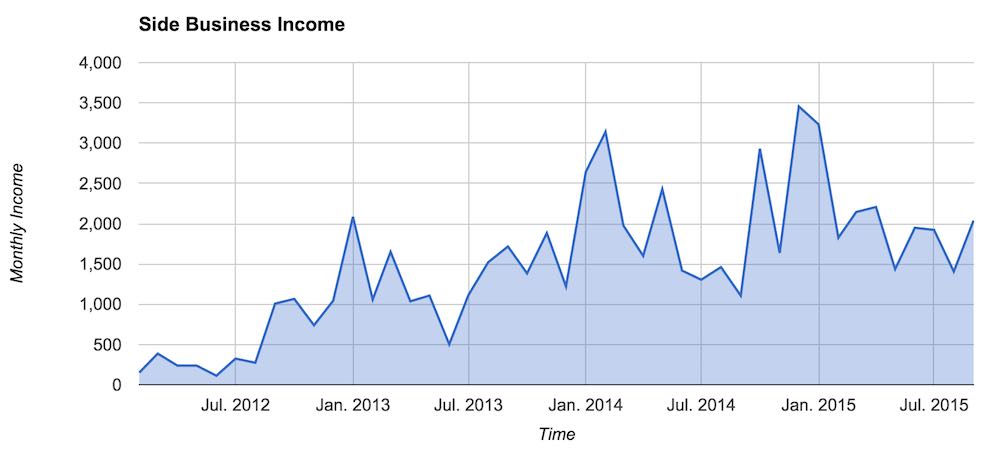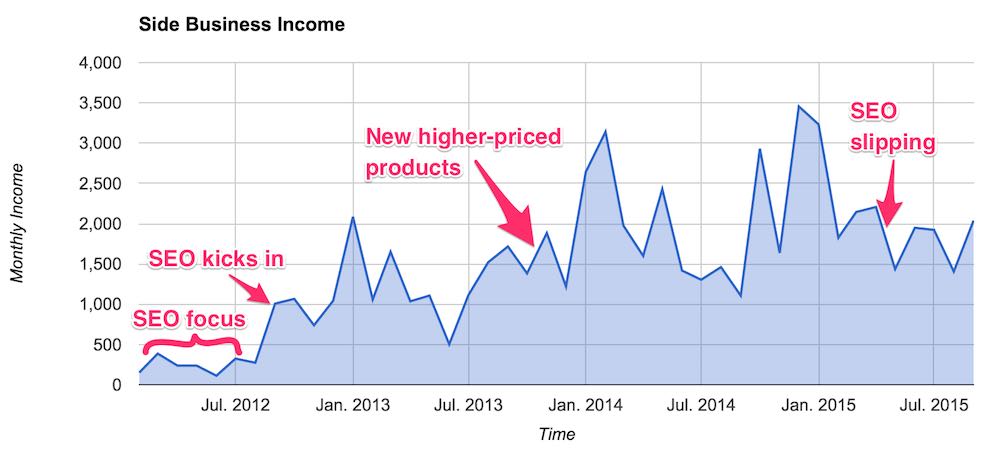
As you may know from following this blog, in my inaugural income report post, I wrote that when I started the Hack Your Wealth website on the eve of my marriage, I wanted to “baseline” my net worth and understand my financial past in order to figure out what, if anything, I should change to grow my — and my newlywed’s — financial future.
I wanted to take stock of my income, spending, savings, and investments to understand how my net worth trended since I entered the workforce after graduate school.
In this post, I’ll analyze how my side projects have performed and share how my thinking about them has evolved. I’ll also give you the exact tools I created to do this analysis as well.
Since this site is about hacking wealth, I will also show you the actual revenue generated from my online products.
I’ll share key insights I learned from launching my side projects and I’ll also offer some actionable takeaways to help you get started with — or grow — your own income-generating side projects so you can create and grow multiple income streams to help you build wealth more quickly.
What Was I Earning Online And Why?

I wanted to understand a few things about my online side projects:
- What was I earning each month from my online products?
- What made them perform well (or poorly)?
- What have I learned as a result about how to create successful online products?
Here is how my online side business income has trended since the beginning.
 I created a spreadsheet template to analyze this that lets you input key info and then spits out visual charts like this.
I created a spreadsheet template to analyze this that lets you input key info and then spits out visual charts like this.
Get the Exact Spreadsheet Template I Created to Analyze My Income, Expenses, and Net Wealth
For context on the income chart above, I currently sell four products online:
- A training video series on how to build a leveraged buyout model
- A training video series on how to build a 3-statement valuation model
- An e-book on breaking into private equity investing
- An e-book on winning admission to an elite law school
They monetize all right. I’ve learned a few lessons and insights through developing and driving traffic to my websites.
First, the insights…
1. My side projects are passively earning an entry-level college grad’s salary, but only after investing the upfront sweat equity to set everything up

Here is what my side projects have brought in since I got started in February 2012:
- 2012: $5,576
- 2013: $16,274
- 2014: $25,101
- 2015 YTD: $18,162
- Last 12 months: $26,187
As you can see, in the last 12 months, my sites brought in just over $26k, which is a little bit less than an average college grad’s annual salary.
It isn’t bad for products that are fairly passive. Other than occasional optimization and customer support, the websites don’t require much time to maintain — only a couple hours per month.
To be sure, they did require quite a bit of upfront work: setting up the website infrastructure, optimizing layouts and design, writing blog content, creating paid product content, occasionally updating paid content, and optimizing for SEO.
But once the machinery is set up, it’s pretty passive income. And other than falling in Google’s rankings, which does take some effort to keep up, no one can take that income stream away. It’s a great feeling.
In full transparency, I’ve also tried launching several online products that failed. For example, I tried launching e-books on how to win elite scholarships, how to break into the tech industry, and how to transition from healthcare into management consulting, among other products. They netted a few sales, but not enough to support maintaining the product. So I shelved those ideas.
2. Initial revenue growth came from focusing on SEO

Let’s go back to the original chart and overlay some annotations to show what happened…

Get the Exact Spreadsheet Template I Created to Analyze My Income, Expenses, and Net Wealth
Now, how do you get discovered in the beginning?
When you start out, your website feels like a lonely boat in the middle of a wide ocean: how will users discover you? After all, they have to actually visit your site in order to make a purchase.
I realized from Day 1 that the most important distribution channel for my niche sites would be Google.
The customer I visualized was someone searching on Google for answers to technical questions that my premium content could answer. If they landed on my site and found valuable content, they might want to make a purchase to get the premium content.
To do that, I had to figure out how to rank highly in Google’s organic search results, which is the definition of Search Engine Optimization, or SEO.
I read some SEO best practices on the Moz blog and other posts online and I implemented a bunch of techniques on my niche sites. I’m not talking about anything fancy — just basic hygiene.
I made sure my title tags, URL keywords, H1 tags, and keyword density were logical and user-focused. I thought carefully about the keyword matches I wanted to rank for, and made sure to seed my content with those keywords where it made sense to.
But that’s about it.
And, indeed, for a niche that isn’t in a hyper-competitive space, there isn’t too much more I’d recommend doing to start; instead, I would focus all your remaining time on creating the most useful content for your users as humanely possible.
One additional thing I did that helped with SEO was some basic outreach to universities. I figured my customers would either be folks presently working at companies but contemplating career changes, or students thinking about how to launch their careers in the first place.
So I approached colleges and universities, and specifically I reached out to student clubs that might have an interest in my website topics: pre-law associations at colleges, finance and investing clubs at business schools.
One useful SEO tip to know is that getting .edu or .gov domains to link to you delivers an outsized impact in terms of search engine rankings.
That’s because you can’t go and just buy these domains by yourself, like you can for a .com or .org domain. So it’s harder to fake links using .edu or .gov domains. Moreover, academic and government websites tend to all be legit sources of website content, so Google gives them special weight when calculating PageRank and domain authority, which benefits link recipients in terms of SEO.
3. A second revenue jump came from new, higher-priced products

In the summer of 2013, I saw another revenue jump. This time it wasn’t so much because of SEO as it was because of a new higher-priced product I launched for my private equity website.
I was thinking about how I could extend the site to adjacent related products and one thing I had heard from my e-book customers was how useful it would be to have a step-by-step Excel video tutorial showing you exactly how to build an LBO model from scratch.
The reason why this is useful is because, when you interview for private equity associate jobs, part of the interview consists of a multi-hour Excel modeling test. You are given a pitch book with financial and operational data, and your task is to build an investment spreadsheet model to evaluate whether the company being pitched is a good LBO investment opportunity.
Creating the course took a lot of hard work because I had to design the curriculum from scratch, create the presentation slides, configure the screen recording software, and then actually record myself teaching the material.
I also had to figure out how to host the videos on my site without sucking up too much server resources. Finally, I had to figure out how to deter piracy and downloading of the videos, because if one week after launch all the videos just showed up on YouTube, it would have been a tremendous wasted effort for me.
Shortly after launching the videos, I started booking sales. And while the unit sales volume for this product has been relatively low, it’s at a much higher price, so the revenue is still meaningful in the aggregate.
4. Growth in 2015 slowed, I believe due to a fall in SEO

In 2015, the year I launched HYW, traffic to my websites dampened a bit. I believe this was because my rankings in Google fell a little bit toward the beginning of the year, as more competitors entered the market.
I hadn’t actively added new free content to the sites in a while and Google was likely taking that into account.
The reason why maintaining your Google ranking requires effort is because Google constantly re-evaluates your site to determine whether new original content has been added. If the content on your site goes stale for a while, Google eventually starts lowering you in the rankings (assuming your competition is continuously adding new content).
In 2015, I didn’t have the kind of revenue spikes I saw in 2014, but overall monthly average revenue was still a bit higher this year compared to last year.
One reason for that is because, in mid-2015, I created and started offering a second new video training course. This course consisted of step-by-step Excel videos teaching you how to build a 3-statement DCF valuation model from scratch.
The goal was to offer investment banking interview candidates and soon-to-start employees of investment banks a prep course on exactly the kind of modeling and valuation work they would do on the job.
The product has helped support revenue in 2015 and focuses on an adjacent investment banking segment that might also later be interested in the private equity content when they start thinking about exit opportunities.
Ultimately, though, even with the introduction of a new product, traffic and revenue were definitely flattening, and that was likely due to an SEO decline, which I couldn’t deny.
I was a bit sad because I had spent a lot of time and effort creating and marketing the websites, but in the end competitors ahead of me had entire teams working on their websites full-time, all day every day. I was only working on these side projects part-time because I still have a day job that I’m not quite ready to leave yet.
But I haven’t thrown in the towel yet…
My goal is to get a lot more aggressive about growing my online side project income

Having done this analysis, my goal now is to right-side the growth of my online side project income by an order of magnitude — whether it comes from my existing websites or a combination of existing and new online projects.
That’s one reason why I’m writing this down and sharing all my insights in this blog post: to make it real, tangible, and a public commitment of the actions I plan to take to achieve this goal.
For my existing websites, there are a few tactical things I plan to do:
- Re-focus on SEO by cultivating links especially from .edu domains. One strategy I’ll pursue is to offer discounts to student clubs at universities in exchange for a backlink, targeting specifically student clubs that have websites on their mothership .edu domain.
- Drive email sign-ups by providing content upgrades in the form of free checklists, tools, and even live 1-on-1 consultations.
- Build an email autoresponder series for those email sign-ups to deliver useful relevant content for people looking to get into an elite law school or break into the private equity industry.
- Create explainer videos to provide helpful content, tips, and advice to build and nurture the relationship with my audiences on each site. Also create explainer videos to give a preview of what you’ll get when you purchase the premium content on each site.
Recently, I’ve been reading a lot about (and taking a lot of inspiration from) techniques other sites use to cultivate their audiences and email lists, including leveraging their free content to efficiently acquire more customers and distribute their paid products.
The initiatives bulleted above will implement these techniques, and I’ll report again in future income reports on how they are performing.
Now it’s your turn: 7 actionable takeaway lessons

This post wouldn’t be complete without some actionable takeaways. So what would I recommend to those of you who are also interested in creating online products to sell?
LESSON #1: Creating content so valuable that people want to pay for it is really hard. It doesn’t just come out of thin air. Even if you have desirable knowledge in your head, writing or recording it into a format that is educational, engaging, and well-curated takes a lot of thought and hard work.
There are some heuristics I have developed about the kind of premium content I believe people are willing to pay for. I look for one or more of the following criteria:
- The content is better and more cleanly organized than users are likely to efficiently find on their own via free resources (for instance, there is a ton of free content on YouTube, but it’s super fragmented and not well organized)
- The content contains insightful, step-by-step actionable tactics from people the user might not otherwise be able to contact or interact with; ideally these tactics take less than 1 hour to implement and result in a clear small measurable win for the user
- The content is proprietary and cannot be obtained anywhere else

In fact, if you are creating an information product, my advice is to focus all your energy on creating as useful and high-quality content as humanely possible. There really is no trickery or marketing that’s going to drive your sales if your product isn’t fundamentally useful.
LESSON #2: Create something that addresses an acute pain point for a particular niche. You want to sell aspirin rather than vitamins, because the former relieves immediate pain whereas the latter only contributes to a theoretical future benefit.

The mental model you want is a user who is suffering an acute pain point and, in a pinch, they suddenly start aggressively searching online for a solution. A user with that profile is banging on any door they can to buy a product that can help them.
I can’t tell you how many times customers have purchased from me because they had an interview or application deadline in less than 48 hours and they were scrambling to prepare.
LESSON #3: Focus on teaching something practical, and ideally technical. Customers want products that teach them something technical and hard, something they can click rewind to watch as many times as they need, something that provides exact scripts, step-by-step instructions, and frameworks for solving discrete problems.

That’s why so many websites are successful at selling (high-priced) how-to videos on coding websites in Ruby on Rails, building financial models, or using Photoshop.
Online informational products that teach fuzzier skills don’t monetize nearly as well. For instance, if you try to sell videos on successful job interviewing, or discussing your leadership experiences, or overcoming adversity, you’re fighting an uphill battle.
Don’t get me wrong: those things are extremely important for many desirable jobs — perhaps even more important for predicting actual job performance than, say, solving technical interview questions. However, the market isn’t necessarily willing to pay for what is important in real life.
Products that don’t have immediate, concrete technical value tend not to do as well, for at least two reasons.
One, when it comes to fuzzy needs like answering behavioral job interview questions well, every person’s needs are highly customized. That’s because something like behavioral job interview questions (and their answers) are highly dependent on individual circumstances and experiences.
It’s almost impossible to create a product with that degree of customization, because products must inherently be generic to be sold at any reasonable scale.
If you wanted to provide the kind of custom solution / coaching that people would actually be willing to buy, you’d basically have to offer consulting services.
I think that’s why there is such a large cottage industry of college admissions consultants.
They sell their time to advise individual applicants, and they may even use the same general playbook of application strategies for every single client. But every client is going to have extremely customized needs.
Consequently, the general strategy playbook must be adapted to fit the unique circumstances of each client, and the admissions consultant plays that “translation” role. They translate the general playbook into specific strategies for each client. It’s hard for a computer (which is only good at scaling repeatable identical things) to emulate this kind of customization.
The second reason fuzzy products don’t do as well is because it’s not clear how to measure what value was actually received. Because non-quantitative, non-technical informational products carry more ambiguity around their value, there will naturally be more skepticism around their price.
If the price is too high, the product will seem too expensive and not worth it. If the price is too low, the value of the product will be called into question. And if customers have to spend too much time going back and forth making up their minds about it, many of them will just give up and not convert.
LESSON #4: Spend the time (or money) to invest in a good design for your product and website. Your website is your storefront and represents your product and brand. If your design sucks, it will make potential customers skeptical of the product quality as well.
And while perception isn’t necessarily reality, it plays a powerful role in influencing customers about the perceived value of your product.
Clean, simple design is the most powerful lever you have to set a good (or bad) impression once users have already clicked to your website.

LESSON #5: Focus your initial marketing efforts on SEO. Mobile phones and social media may be all the rage, but for intent / research-based discovery, nothing beats plain old fashioned search.
Also, don’t take SEO for granted even when you’re at the top. Just because you got to the top of the Google search results for your desired keywords does not mean you will keep that privileged position forever.
You need to keep creating high-quality content for the Googlebot to crawl, and for readers to share and link to, in order to stay competitive in organic search results.
A quantitative analysis shows that the top 3 results on the Google search results page net more than half of all clicks (~55%); the top spot nets more than 30% of all clicks.
It may feel tedious to optimize for Google, but boy does it pay off.
LESSON #6: If you can afford it, experiment with buying ads. Not only are Google and Facebook ads a good way to test potential demand for product concepts (trying to build SEO for concept websites takes too long), but it’s also a way to actually get customers and book sales.
One word of caution, though: Google now often places multiple ads at the top of search results. So if you are bidding on keywords that you also rank highly on organically, you just want to be sure you feel confident that the customers clicking your top-placement ads wouldn’t have otherwise clicked on your organic search results absent those ads. Otherwise, you’re just cannibalizing organic customers with paid search customers. There won’t be a quantitative way for you to prove this, so you just have to use your gut instincts.

Also, you want to be really, really sure your revenue exceeds your customer acquisition cost, otherwise you’re flushing money down the toilet. Your customer acquisition cost for Google and Facebook ads is your average cost per customer conversion — i.e., the total number of ad dollars you paid out divided by the total number of customers from those ads who bought your product.
LESSON #7: Invest maniacally in building an email list from Day 1. Email converts an order of magnitude better than the next best…anything. Plus, you get 6 or 7 missed swings (spam blasts) before a subscriber says, “enough of you,” and clicks the unsubscribe link. Indeed, if a subscriber took the effort to subscribe, that means they saw something valuable in your website to begin with. Harness that trust, nurture it, grow it, and once you’ve delivered a lot of value, then sell into it. An email subscriber is worth multiples more than your average Google clicker.

All right! This was a long analysis, but hopefully you found it interesting and useful, and can apply some of the learnings I stumbled upon to your own side business income-generating wealth hacks.
In a future post, I’ll share tips on how to come up with side business ideas that leverage your unique skills and interests to help you start generating side income.
Until then, be sure to check out the other posts in this series:
- Income and Expenses
- Side Business Income – you’re reading this post!
- Net Worth
Also, please comment below to let me know about your successes! It’s one of my favorite things to hear from you. As well, if you have any wisdom to share about your own entrepreneurial efforts, I’d love to hear them! I try to respond to all comments and email. 🙂
Wow your website is amazing, as tax preparer and investor I been expending a lot money just to learn what your share in your website for free.
Your are awesome keep going, congratulations!
Thanks!